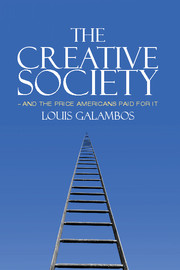Book contents
- Frontmatter
- Contents
- Preface
- 1 1931
- 2 Life, Death, and Learning in the Cities
- 3 Toward a New Economy, 1890 to 1930
- 4 State Crafting – American Style
- 5 Confronting the World
- 6 Winners and Losers, 1890 to 1930
- 7 New Deal Experiments
- 8 Fighting On God’s Side
- 9 The New Aristocracy, 1946 to 1969
- 10 The Suburban Conquest of the 1960s
- 11 Empire in the American Century
- 12 The Tattered Empire of the 1970s
- 13 The Cracked Core
- 14 The American Solution, 1981 to 2001
- 15 Conservatism: Rhetoric and Realities, 1981 to 2001
- 16 The Hegemony Trap
- 17 The American Dream, 1981 to 2001
- 18 The Creative Society in Danger
- Acknowledgments
- Index
- References
4 - State Crafting – American Style
Published online by Cambridge University Press: 05 June 2012
- Frontmatter
- Contents
- Preface
- 1 1931
- 2 Life, Death, and Learning in the Cities
- 3 Toward a New Economy, 1890 to 1930
- 4 State Crafting – American Style
- 5 Confronting the World
- 6 Winners and Losers, 1890 to 1930
- 7 New Deal Experiments
- 8 Fighting On God’s Side
- 9 The New Aristocracy, 1946 to 1969
- 10 The Suburban Conquest of the 1960s
- 11 Empire in the American Century
- 12 The Tattered Empire of the 1970s
- 13 The Cracked Core
- 14 The American Solution, 1981 to 2001
- 15 Conservatism: Rhetoric and Realities, 1981 to 2001
- 16 The Hegemony Trap
- 17 The American Dream, 1981 to 2001
- 18 The Creative Society in Danger
- Acknowledgments
- Index
- References
Summary
Whether Americans lived on a farm or in a city, they had long been the least-governed people in the developed world. State and local governments did their best to fill this void. But insofar as modernization in Europe involved the creation of national administrative states – that is, a national government with a formidable bureaucracy – the United States was still premodern as late as the 1890s and apparently enjoying its unique brand of political innocence. Of course this bliss didn't last. During the next four decades, the country struggled to create new forms of national governance consistent with the needs of a very large, urban, industrial society.
In a rapidly expanding democracy with fluid class boundaries and an economy experiencing alternating surges of growth and depression, state building was at best a haphazard undertaking. The profession that played the leading role in that bitterly contested and bruising process was the law. Party politicians, reformers, the clergy, bureaucratic entrepreneurs within government, even economists, sociologists, philosophers, and an occasional historian made proposals. As would the representatives of the myriad interest groups eager to shape every political decision. Business would, of course, have its say. But it would largely be lawyers who would craft the compromises essential to an American democratic society. The lawyers dominated the entrepreneurial gap in politics. Like young parents trying to shop with their children in tow, the lawyers usually had more help than they wanted. But their profession was accustomed to conflict, hardened to defeat, and strategically positioned to shape the emerging American administrative state.
- Type
- Chapter
- Information
- Publisher: Cambridge University PressPrint publication year: 2011



